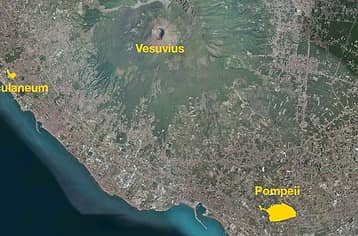- Home
- Visiting the Crater on Mount Vesuvius
Visiting the Crater on Mount Vesuvius

Mount Vesuvius is one of only two active volcanos in Continental Europe and stands about 1281 meters tall, with a symmetrical central cone and steep wooden slopes. The whole of the Mount Vesuvius National Park is both beautiful and productive, dotted with small farms and wineries planted with heirloom varietals boasting a unique terroir. Visiting the crater is a must, and tourists from across the globe climb the path each year to peer into its depths.
The curious have been climbing the slopes of Mount Vesuvius since the 1600s, as the crater was considered one of the more "exotic" stops on the Grand Tour, attracting tourists from northern Europe who had never seen a volcano.
Between the 18th and 19th centuries, the ruins of Pompeii stop along the 'were discovered by chance, and a trip to Pompeii-Vesuvius became a cultural attraction, as well. Many travellers who were drawn to the unearthed city also wanted to see the volcano that had destroyed it, and excursions up the mountainside were a huge draw'.
From the 18th century to today, hiking up Mount Vesuvius is one of the most popular activities in the area; the Volcanological Observatory, founded in 1841, and the official Mountain Guide Association, founded in 1855, have expert guides able to accompany tourists up the final stretch of the mountain trail.
Still today, the most popular route among visitors is the trail up the highest reaches of the cone to the rim of the crater, a stretch that is not particularly difficult, can be undertaken by anyone, and does not require hiking experience.
The trail is about 4 km up and back, with a change in altitude of about 140 meters and an average slope of 14%; the trail reaches 1,170 meters above sea level.
There are buses and shuttles that climb the lower slope of Mount Vesuvius, stopping at the ticket office at 1,050 meters above sea level. The trail begins here, offering views of the Vesuvius park overlooking the Tirone Reserve, the Bay of Naples, and the Campanian Plain. About halfway up the trail you can begin to see Punta Nasone and, on the opposite side, Cognoli di Ottaviano towering over the Valle dell’Inferno. Continue along the broom-lined route to the short climb under maritime pines and birch trees to the Forest Service Post. Pass this to the crater rim with its breathtaking view over the entire Bay of Naples, Pompeii ruins, and Apennine mountains of Molise and Abruzzo.
Getting to Mount Vesuvius
Getting to Mount Vesuvius
You can reach the Mount Vesuvius National Park by car or with one of the bus services from Pompeii or Herculaneum.
If you are arriving by car, take the A3 Napoli-Salerno highway to the Torre del Greco or Herculaneum exit, and follow the signs for Vesuvio. At 800 meters above sea level, there is an unstaffed parking area that costs EUR 5 for all day. Shuttles to the ticket office depart from here, and cost EUR 2 round trip (free for children). We suggest taking the shuttle as it is a tough climb from the parking area to the ticket office, and it's best to save your energy for the trail!
By public transport, you can take the bus or shuttle from the Circumvesuviana Pompei - Villa dei Misteri stop or the Circumvesuviana Ercolano Scavi stop; buses and shuttles cost about EUR 22 round trip (entrance to the park included) and take you directly to the ticket office that is about 200 meters below the trail head for the crater. There are also EAV bus routes between the Pompeii and Mount Vesuvius every 50 minutes.
Visiting the Crater on Mount Vesuvius - Opening & Hours
January, February, November, December - daily from 9am to 3pm
March and October - daily from 9am to 4pm
April, May, June, September - daily from 9am to 5pm
July and August - daily from 9am to 6pm
Barring inclement weather or unforeseen circumstances, the trail to the crater is open all year round, including Sundays and holidays.
Visiting the Crater on Mount Vesuvius - Ticket price
EUR 10: adults
EUR 8: students
Free: children shorter than 120 centimeters; disabled and companion
Discover more about Mount Vesuvius
Getting to Pompeii and Herculaneum